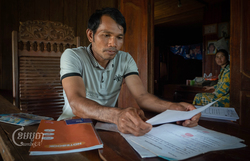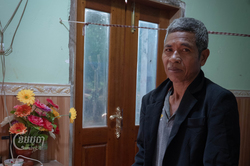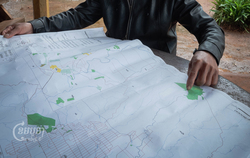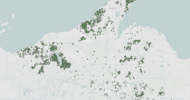After rubber firm deal, Bunong fear broken promises, uncertain land tenure
by Jack Brook and Khuon Narim

Pech Chreada district, Mondulkiri — One year after signing an agreement with subsidiaries of a European rubber conglomerate, Maly Kim lamented that his indigenous Bunong community felt deceived.
The deal was meant to resolve one of Cambodia’s longest-running land disputes, but like other Bunong village representatives who signed agreements with the companies, Kim says his village of Pu Lu has not received most of the benefits they were promised by the firms in exchange for ceding most of their customary land claims.
“The community was happy when we signed the agreement,” Kim recalled in mid-October. “But now we are unhappy. People think the company lied to us.”
Beginning in 2007, Luxembourg-based Socfin Group’s subsidiaries acquired three government-granted economic land concessions encompassing more than 12,000 hectares, which overlapped with ancestral forests and farmland of seven Bunong villages in Mondulkiri province’s Bosra commune.
For more than a decade, some Bunong villagers have been trying to reclaim and gain legal recognition for their customary land, including via multiple rounds of negotiations with Socfin subsidiaries, Varanasi, Sethikula and Coviphama, which concluded in September last year. Some details of the settlement were released this September, in a joint statement issued by the firms and community representatives who negotiated on behalf of 210 families in five villages.
“It took a very long time for these communities to find some common ground with the company,” said Antoine Deligne, deputy team leader of the German, Luxembourg and Swiss government-funded Mekong Region Land Governance project, which funded the mediation.
“The fact that there is an agreement that is really the free will of the communities…that’s the most significant result,” Deligne said.
Socfin has touted the negotiations as a success, saying the company helped provide communities with the opportunity to secure land tenure for their culturally significant sacred forests by mapping Bunong land in Bosra for the first time. Four villages — Pu Lu, Pu Raing, Pu Cha and Pu Teut — can now apply for communal land titles, Socfin said in an email.
Without the titles, indigenous communal land could be reallocated by the state or seized by private interests.
But Pu Lu and Pu Cha village chiefs, and the villages’ lawyer during the mediation, say the communities don’t have sufficient support to finish the land titling process, and members who did not participate in negotiations may be excluded.
All seven Bosra villages have been stalled at the final stages of the titling process since 2012, in part due to the Socfin land disputes and an expensive, complicated bureaucracy, which in the last 20 years has awarded communal land titles to less than 40 of Cambodia’s 455 registered indigenous communities, according to NGO Forum’s Sophea Pheap.
In addition, the outcomes of the negotiations, including the creation of communal land maps, remain opaque — even to Bosra village chiefs — due to confidentiality agreements between Socfin and the 24 community representatives who participated in five separate, village-specific negotiations from 2017 to 2021.
Socfin agreed to allow four villages to apply for communal land titles for 511 hectares of land within the more than 12,000 hectares of concessions, according to the September joint statement.
But Socfin subsidiaries still control approximately 7,000 hectares of Bunong ancestral land in Bosra commune, said Kroeung Tola, a resident of Bosra’s Lam Meh village, which did not participate in the negotiations.
“We don’t have specific data,” Tola said. “Indigenous peoples have never measured specific land sizes.”
Four community representatives in Pu Cha and Pu Lu villages say they felt compelled to accept the company’s terms or risk securing none of the land they claimed.
“It took a long time. We were tired and [negotiation meetings] wasted time we could be farming,” said Brob Tuch Nheb, a Bunong representative who signed an agreement on behalf of Pu Cha village. “We gave up demanding our land.”
Michael Nanz, co-president of human rights NGO FIAN Switzerland, said the agreements “completely succeeded in cementing the status quo” for Socfin.
Today, little of the compensation agreed to by the company has materialized, Bosra community members say.
From Subsistence to Rubber Farming

More than 850 families in Bosra commune held land impacted by Socfin concessions and most unwillingly accepted relocation or monetary compensation from the company, according to a 2011 report from the International Federation for Human Rights (FIDH).
Preliminary land surveys conducted by German development agency GIZ and completed in 2016 found 136 families’ farms were in dispute with Socfin and 30 plots of cemetery, spirit and sacred forests were within the conglomerate’s concessions, but the surveys did not calculate land sizes. A subsequent preliminary mapping project facilitated by consultants in the MRLG-funded Independent Mediation Group mapped communal land in the concessions “for the purposes of mediation and future communal land registration,” said IMG mediator Poch Sophorn.
Approximately 300 hectares of cemetery, sacred and spirit forests would be preserved for the five villages under the recent agreements, according to Socfin’s 2021 sustainability report. The company did not provide specific information about the creation of communal maps.
A recent Socfin agreement allowed Pu Lu village to apply for land titles to protect a spirit forest and a cemetery forest comprising 72 hectares where traditional ceremonies are held and ancestors are buried, said Kim, one of five Pu Lu community representatives who signed an agreement on behalf of 10 families.
Socfin’s sustainability report says the company is also “protecting” 254.6 hectares of community reserve land. But Socfin did not respond to questions about whether the firm or the communities had control of the reserve land.
A Pu Lu agreement says two “reserve forests” will remain in the company’s possession as rubber plantations until Socfin’s concessions expire in more than 50 years. Afterwards, the company said the community could apply for communal titles.
“We had no choice: if we do not agree, they will still take our land,” said Pyoeurl Nien, a Pu Lu representative, as she held her infant son at her Bosra home last month. “But I fear we won’t have land for the next generation.”
She had once grown a mix of mangoes, bananas, cassava and potatoes across her three hectares of land but was forced to give that land up to Socfin and accept land elsewhere, shifting from rotational subsistence farming, as was traditionally practiced by local Bunong people, to monoculture rubber cultivation, as many of her neighbors were forced to do in the past decade.
“Before, I wanted the original land but the company did not agree and gave me three hectares of land in a new place,” she said. “I plant rubber there now.”
Awaiting Development Funds
Pu Lu villagers initially sought 20 to 30% of the companies’ annual revenue for use of their land, Kim said. Through the end of June, Socfin reported 2022 earnings of 112.3 million euros ($112.6 million).
Instead of a share in their profits, Socfin subsidiaries, without specifying a timeline, promised to supply Pu Lu with two water wells, repair two 100-meter road sections and sell rubber budwood to communities to plant on their existing farmland, according to agreements seen by CamboJA. Six families could also gain ownership of 10 hectares of farmland on the edge of a stream within the company’s concessions, according to Kim.
The company agreed to provide $10,000 annually to Pu Lu over a three-year period beginning at the start of 2022, a quarter of the sum as a direct cash contribution to a community representative-controlled fund and the rest provided through community-proposed development projects.
The Pu Lu agreement says the company would finish evaluating development proposals within two months of submission by the community and then help villagers implement the project. Community members said they also hoped to use the company funds to cover medical costs for sick and elderly relatives and support those struggling financially.
But Kim said that after submitting a $10,000 development proposal, seen by CamboJA, in late May, he was told by a company representative that villagers should purchase the rubber and durian trees, water pumps and other supplies themselves, and then apply for reimbursement.
“The company told us to find the people who sell the rubber trees and then go get the receipts,” Kim said. “But the community didn’t have the money; we needed the money from the company.”
Socfin was unclear about the process to receive funds, said Legal Aid Cambodia (LAC) lawyer Run Saray, who represented community members during the mediation.
Confused about the agreement’s procedures and believing they would be reimbursed, some villagers like Kim said they took out microloans to cover the costs. Kim said he must pay $200 a month in total interest payments for multiple loans taken out this year. He used a hard title for the land beneath his home as collateral.
“The community representatives did not consult or inform the company before conducting their project,” a Socfin representative said in an October 26 email. “All requests submitted by the communities that participated in the mediation on related farmland have been acknowledged and are being addressed.”
Cash contributions would be given to communities this month, Socfin added.
The firm said Pu Lu villagers had already acquired rubber budwood and received technical training on rubber farming from the company this year, while residents of Pu Raing village had received a rice dehusking machine in October.
Along with building four bridges, Socfin said it had “improved and maintained over 11 kilometers of roads” for the communities. While Kham Pornchea, Pech Chreada district deputy governor, said the company had done road work in the commune, Bosra commune chief Yert Sarin said the company had not completed any development projects this year.
Community representatives in Pu Cha village said they signed a similar set of agreements with the firms, providing $9,000 in development funds annually from 2022 to 2026.
The Pu Lu and Pu Cha agreements say if annually allotted development funds are not used within the calendar year, they will be kept by the company and “re-discussed” at the end of the disbursement period.
Socfin Cambodia general manager Jef Boedt and sustainability manager Bénédicte Nicoleau signed the agreements on behalf of the company subsidiaries. They did not respond to requests for comment.
Rubber-Farming Families
The Pu Lu agreements did not include new contracts with families farming rubber plots within the Socfin concessions, another aspect of the land dispute. In total, 52 families, including displaced Bosra Bunong families, farm 136 hectares of rubber within the concessions, part of an earlier compensation offer from the company, according to Socfin’s 2021 sustainability report.
“As the mediator has no experience in contract farming or credit/loan” it was not possible to finalize new contracts and would be too time consuming to negotiate with individual families holding contracts with the firms, said Sophorn, the mediator. He declined to comment on other aspects of the Socfin deals, citing their confidentiality.
As their rubber-farming contracts currently stand, villagers are required to pay the company $1 per rubber tree (or over $500 per hectare of rubber plantation, on average), according to five community representatives in two villages, and Kim’s land use contract with Socfin from 2014. The contract also included maintenance costs and 5% interest accumulated over more than 10 years, showing that Kim owed the company more than $5,000 for his 2.8-hectare plot.
Kim and his neighbors say they have refused to pay the company because the costs are too high.
“I am now feeling afraid, some people have said that we will have to return [the land] to the company because we are not able to pay,” said Nge Nam, another Pu Lu representative and rubber farmer who estimated he owed the company more than $10,000.
The community and the firms will agree to new payment terms for use of rubber farmland inside the concessions, the Pu Lu agreement says, stipulating that the company would deliver revised contracts in June this year.
Socfin, however, acknowledged that new contracts have not been provided. Despite this, the community’s lawyer Saray said the legal aid funding to represent the Bunong in Bosra ran out in September, so all LAC can offer is remote consultation.
Deligne, of mediation funder MRLG, suggested communities could request help from local officials to ensure outstanding agreements were upheld.
He admitted the mediation results were “probably not as good as what a normal judicial process would have delivered.” However, Deligne noted that in all likelihood “a judicial process was not possible.”
Aurélie Righetti, of the Swiss Agency for Development and Cooperation, which provided MRLG with $490,000 in funding from 2013 to 2022, said her organization was awaiting the results of an external review of the mediation before commenting on the process and outcome.

Communal Land Titles Uncertain
The details of the agreements, especially the status of the communal land maps between Socfin’s subsidiaries and the villages involved in mediation, appear vague to most community members.
Representatives from Pu Lu and Pu Cha villages say they received only one original copy of each agreement and shared no information with their neighbors during the negotiations due to a confidentiality agreement imposed by the company. Socfin and MRLG said confidentiality was accepted by all parties to build trust.
“I don’t know the reason [for the confidentiality agreement]. The company did not give any explanation,” said Brop Tuch, the Pu Cha community representative. He said he consented because “we were concerned the negotiations would not go well and I was scared, scared that the company would not give the land back.”
Even after the negotiations concluded, Pu Lu villager Klang Po said Kim and the other Pu Lu representatives did not share the outcome with others. “Whether the result is good or not they never told us,” Po said.
He serves as a plaintiff in a lawsuit against Socfin shareholder, Bolloré. In July 2021, a French court ruled against the 97 Bunong families who brought the suit seeking the return of communal land, on the grounds that they did not have legal land titles when Socfin subsidiaries received their concessions. A lawyer for the Bunong communities said they are appealing the decision.
Current Pu Lu village chief Thanh Him and Maly Phin, the former village chief during the mediation process and Maly Kim’s brother, both said they had never seen a new communal land map for their village and were not sure what land would be included following the mediation. They chose to participate in the lawsuit in an attempt to reclaim their farmland, instead of participating in the negotiations, but they also want to benefit from a communal land title.
While the company and MRLG have maintained that communal land titling only applies to spiritual, cemetery and reserve forests, families’ residential and customary farmland are also eligible for communal land titles, according to a 2009 sub-decree on indigenous land registration.
“I want my land to be part of the communal land title,” Po said. “If we get an individual title, we will be cut out from the community.”
Bunong customary farmland not included in the agreements — the majority of farmland used by Pu Lu villagers, according to village chief Him — will not be eligible for titling until after the concessions end, because it remains disputed and was not part of Socfin-approved mapping.
“It is not right, it’s unfair,” Him said. “The company will be allowed to use the land for 50 more years, then hand the land to the state without the [communal land] title.”
Following negotiations, lawyer Saray said no communal land maps were produced, but the company and community agreed on the boundaries of each other’s land, which could serve as a first step to producing official maps needed for a communal land titling application.
Socfin said it marked agreed upon communal land boundaries with 138 information boards within the concessions to protect the land while communities wait for official titles. The next steps in the process, which Saray said have not started, will likely take years and cost tens of thousands of dollars, according to a 2021 U.N. report.
Bunong villagers can use the Socfin-recognized communal land now, but the land titling process is too difficult to go through alone, Saray said.
“They need some NGO to help support them,” but none of the communities have an organization actively helping them now, he said.
The bottom line, Saray added, is Socfin is not responsible for securing the communities’ land tenure.
“It’s not the company’s problem, that is the community’s problem,” he said.
Land Management Ministry spokesperson Seng Lot and Mondulkiri deputy governor Cheak Mengheang said they did not have information on the status of the Bunong villages’ communal land title applications.
Standing on the edge of York Lorn forest spirit forest, spared by Socfin but still lacking a communal title, Pu Cha village representative Brut Tha said he was grateful that his community had at least retained this forest, surrounded by rows and rows of rubber trees.
“I hope we will get just 50% of what the company said they would provide in the agreement,” Tha said. “But we are still not 100% sure.”













